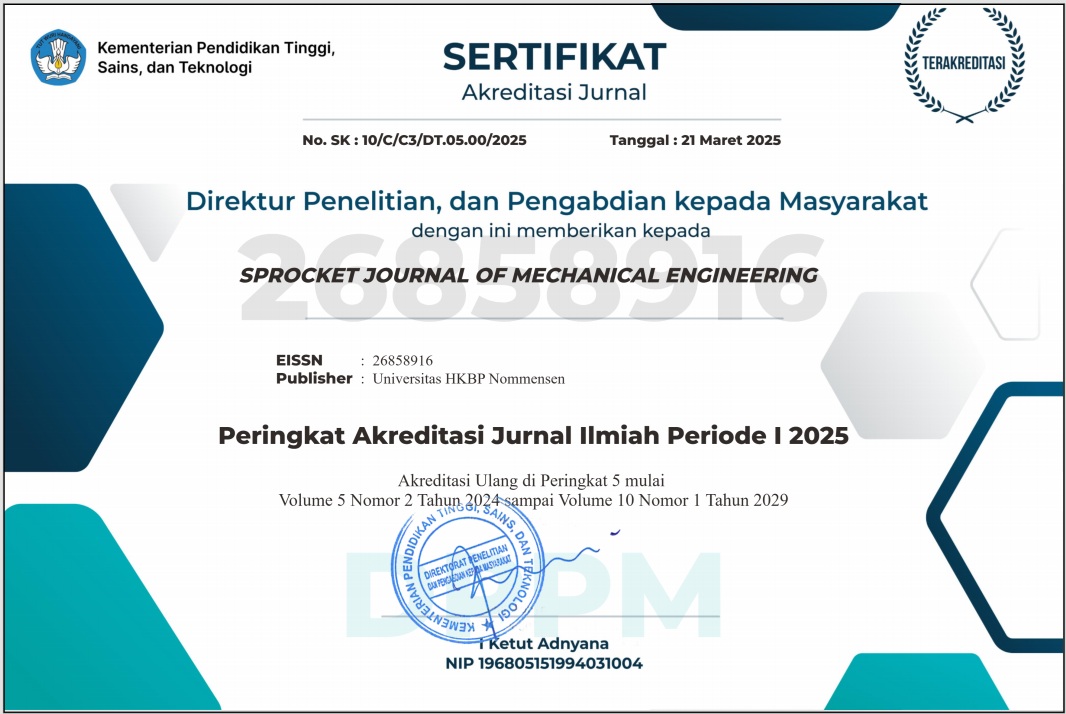Studi Eksperimen Pengaruh Variasi Besaran Sudut Buang Dan Sudut Bebas Menggunakan Pahat Tepi Rata Dengan Material Pahat HSS Terhadap Kekasaran Permukaan Pada Proses Pembubutan Benda Kerja Dengan Material Benda Kerja St 41
Abstract
A good level of surface roughness as one of the benchmarks for turning the workpiece is said to be of high quality. As a cutting tool, lathe chisels need free angles and exhaust angles according to the desired specifications. This study aims to determine the effect of variations in the size of the tool angle and how much free angle and exhaust angle are best used on the surface roughness of St 41 steel. The study was conducted using a lathe brand Bemato series 44376 with process parameters consisting of a spindle speed of 280 m /min, the infeed depth is 0.8 mm, and the infeed speed is 0.040 mm/rev. The research method used is an experimental method and the results of the turning process are measured the level of surface roughness using a surface roughness tester. Based on the results of the specimen measurements, it is found that there are differences in surface roughness produced by variations in the free angle (α) and exhaust angle (β). As for the lowest roughness value of the whole specimen turning process is in the turning process with variations in angle 6° and angle sudut 10° with a surface roughness value (Ra) of 2,555 m.
References
[2]. Hendrawan, A. (2015). Pengaruh Jenis Pahat Terhadap Kekerasan Permukaan Pada Saat Pembubutan Baja St 41. Jurnal Nozzle Volume 5 Nomor 2, Hal. 147-149.
[3]. Paridawati. (2015). Pengaruh Kecepatan dan Sudut Potong Terhadap Kekasaran Benda Kerja Pada Mesin Bubut. Jurnal Imiah Teknik Mesin, Vol. 3, Hal. 53-67.
[4]. Pramawata, P. (2013). Pengaruh Jenis Pahat, Sudut Pahat, Dan Kedalaman Pemakanan Terhadap Tingkat Kekasaran Dan Kekerasan Pada Proses Bubut Rata Baja St 42. JTM. Volume 01 Nomor 03, Hal. 56-64.
[5]. Priyadi, S. (2017). Pengaruh Sudut Pahat Pada Proses Bubut Rata Terhadap Tingkat Kekasaran Permukaan Benda Kerja. Semarang: lib.unnes.ac.id.
[6]. Raul, Widiyanti, & Poppy. (2016). Pengaruh Variasi Kecepatan Potong Dan Kedalaman Potong Pada Mesin Bubut Terhadap Tingkat Kekasaran Permukaan Benda Kerja St 41. Jurnal Teknik Mesin, Tahun 24, No. 1, Hal. 1-9.
[7]. Sumbodo, W. (2008). Teknik Produksi Mesin Industri Jilid 2. Jakarta: Direktorat Pembinaan Sekolah Menengah Kejuruan.
[8]. Susarno, A. (2012). Studi Pengaruh Sudut Potong Pahat Hss Pada Proses Bubut Dengan Tipe Orthogonal Terhadap Kekasaran Permukaan. Surakarta: eprints.ums.ac.id.

This work is licensed under a Creative Commons Attribution 4.0 International License.
Penulis yang menerbitkan dengan SPROCKET JOURNAL OF MECHANICAL ENGINEERING menyetujui ketentuan berikut :
- Penulis memegang hak cipta dan memberikan jurnal hak penerbitan pertama dengan karya yang dilisensikan secara bersamaan di bawah Lisensi Internasional Creative Commons Atribusi 4.0 . yang memungkinkan orang lain untuk berbagi karya tersebut dengan pengakuan atas kepengarangan karya dan penerbitan awal dalam jurnal ini.
- Penulis dapat membuat pengaturan kontraktual tambahan yang terpisah untuk distribusi non-eksklusif atas versi jurnal yang diterbitkan dari suatu karya (misalnya, mempostingnya ke repositori institusional atau menerbitkannya dalam sebuah buku), dengan pengakuan atas penerbitan awalnya di jurnal ini.
- Penulis diizinkan dan didorong untuk mengunggah karya mereka secara daring (misalnya, di repositori institusi atau di situs web mereka) sebelum dan selama proses penyerahan, karena hal ini dapat mengarah pada pertukaran yang produktif, serta kutipan yang lebih awal dan lebih banyak dari karya yang diterbitkan (Lihat Pengaruh Akses Terbuka ).






.png)
.png)

